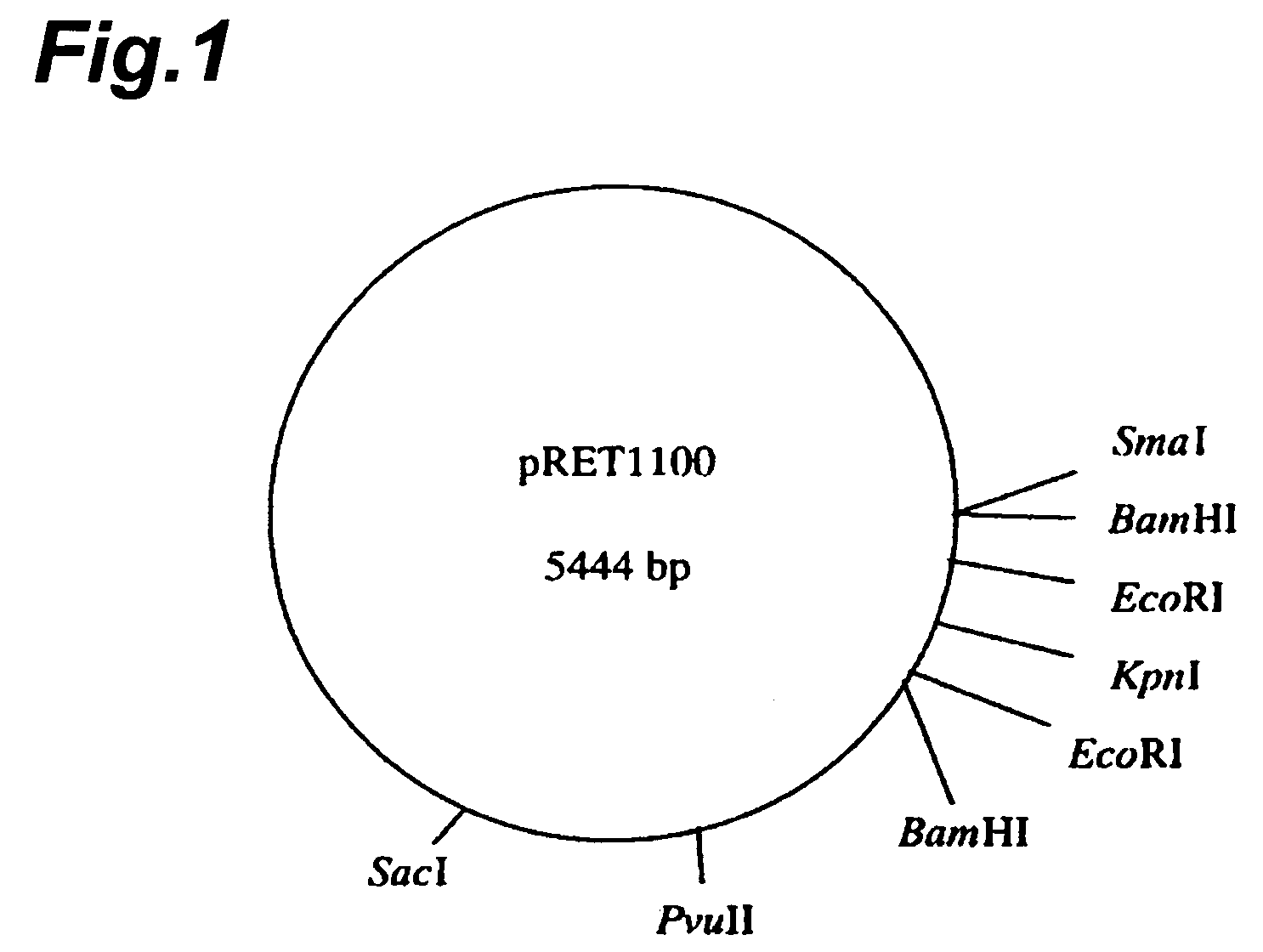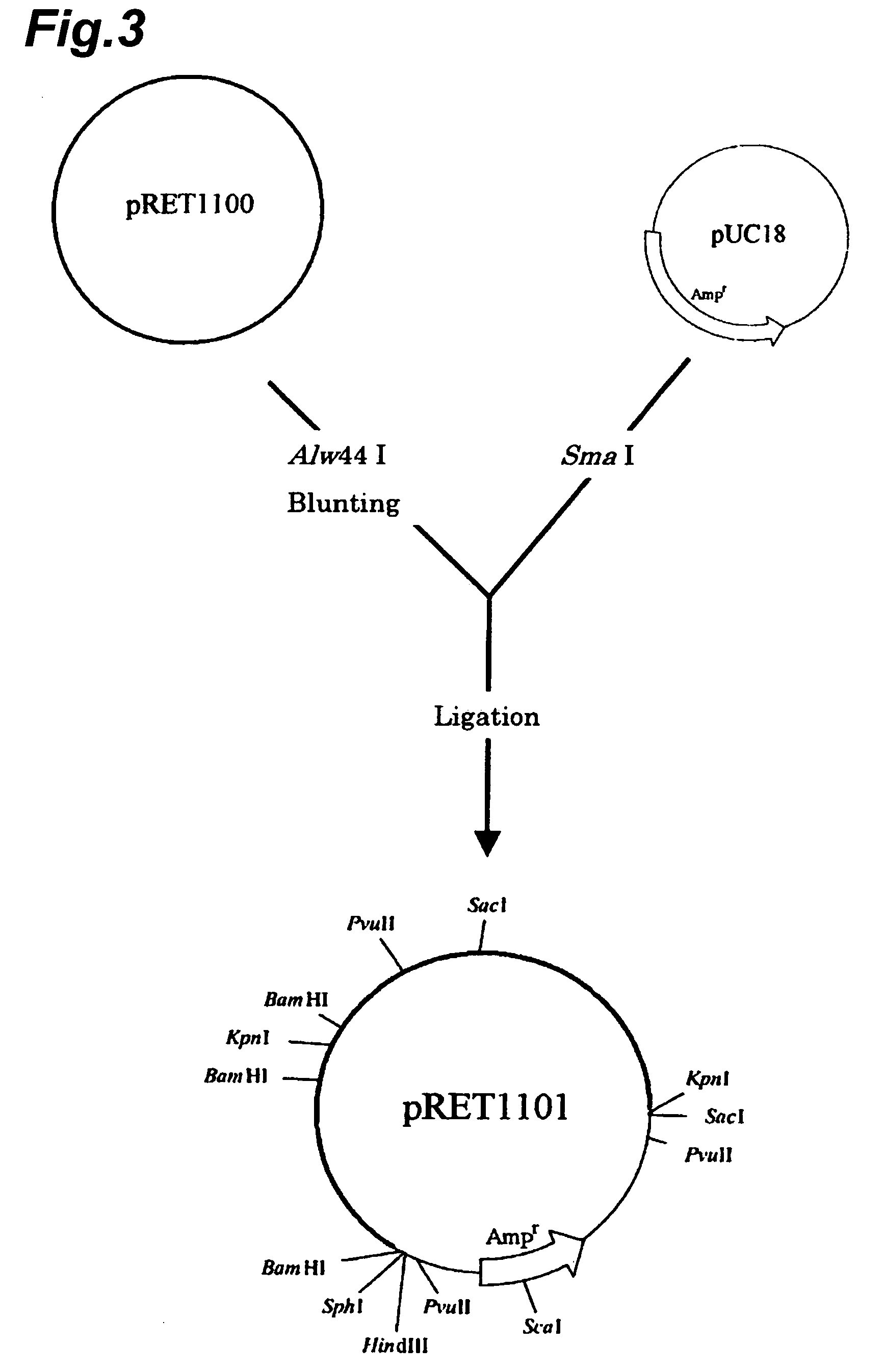Plasmids and utilization thereof
a technology of plasmids and plasmids, applied in the field of plasmids, can solve the problems of genus rhodococcus /i>as hosts lagged behind in developing vectors and suitable ones
- Summary
- Abstract
- Description
- Claims
- Application Information
AI Technical Summary
Benefits of technology
Problems solved by technology
Method used
Image
Examples
example 1
Isolation and Purification of Plasmids
[0180](1) Method
[0181]Rhodococcus strains were inoculated to 5 mL of GPY medium (1% glucose, 0.5% bactopeptone, 0.3% yeast extract) and cultured with shaking at 25° C. After adding 250 μL of a 100 mg / mL ampicillin solution in the logarithmic growth phase, culturing was continued at 25° C. for 2 hours with shaking. The cells were harvested by centrifugation (12 krpm, 5 min), and after removing off the supernatant, they were suspended in 1 mL of 50 mM Tris (pH 7.5), the cells were again harvested by centrifugation (12 krpm, 5 min) and the supernatant was removed off. They were then suspended in 250 μL of a 10 mg / mL lysozyme solution dissolved in TE solution (10 mM Tris (pH 7.5), 1 mM EDTA), and the suspension was allowed to stand at 37° C. for 30 minutes. Next, 100 μL of 3 M sodium chloride and 25 μL of 10% SDS were added and the mixture was allowed to stand at −20° C. overnight. To the supernatant from centrifugation (12 krpm, 5 min) there were a...
example 2
Identification of Restriction Endonuclease Sites
[0187]Various restriction endonucleases were used to determine restriction endonuclease sites, for classification of the plasmids shown in Table 3. Each plasmid was isolated by the method described in Example 1, and then digested with EcoR I, Hind III, Pvu II, Sca I, Sph I, Sma I, Sac I, BamH I and Kpn I, and electrophoresed on 0.8% agarose gel for confirmation of the DNA fragments. The size marker used was Loading Quick DNA size Marker λ / EcoR I+Hind III double digest (Toyobo). The numbers of sites cleaved by the restriction endonucleases and the sizes of the fragments were determined based on the size marker. The results are shown in Table 4.
[0188]
TABLE 4JCMR. rhodniiIAM 1400IAM 1503JCM 2893JCM 28942895JCM 3203pRET1100pRET1200pRET1300pRET1400pRET1500pRET1600pRET1700pRET1800pRET0500pRET1000BamH I2(0.4, 5.0)1(5.4)samesamesamesamesamesamesame2(2.0, 3.8)EcoR I2(0.3, 5.1)1(5.4)asasasasasasas0Hind III00pRET1100pRET1200pRET1100pRET1200pRET11...
example 3
Plasmid Sequencing and Homology Search
[0190]As the plasmids were classified into three types, i.e. pRET1000, pRET1100 and pRET1200 based on the results of Example 2, it was attempted to sequence each of the plasmids.
[0191]First, the DNA fragments of the plasmids were cloned for determination of the nucleotide sequences. For Rhodococcus erythropolis (IAM1400), the plasmids (pRET1100, pRET1200) were isolated and digested with Sma I and Sac I. Upon electrophoresis on 0.8% agarose gel, DNA fragments with sizes of approximately 0.5 kbp, approximately 1.7 kbp, approximately 3.7 kbp and approximately 4.9 kbp were confirmed. The respective DNA fragments were recovered from the agarose gel using a GFX™ PCR DNA and Gel Band Purification Kit (Amersham Bioscience) and used as insert DNA. Separately, pBluescript II KS(−) was used after digesting with Sma I alone or with Sma I and Sac I, as vector DNA. The insert DNA and vector DNA were ligated with Ligation High (Toyobo) and used to transform E....
PUM
| Property | Measurement | Unit |
|---|---|---|
| temperature | aaaaa | aaaaa |
| temperature | aaaaa | aaaaa |
| time | aaaaa | aaaaa |
Abstract
Description
Claims
Application Information
 Login to View More
Login to View More - R&D
- Intellectual Property
- Life Sciences
- Materials
- Tech Scout
- Unparalleled Data Quality
- Higher Quality Content
- 60% Fewer Hallucinations
Browse by: Latest US Patents, China's latest patents, Technical Efficacy Thesaurus, Application Domain, Technology Topic, Popular Technical Reports.
© 2025 PatSnap. All rights reserved.Legal|Privacy policy|Modern Slavery Act Transparency Statement|Sitemap|About US| Contact US: help@patsnap.com



